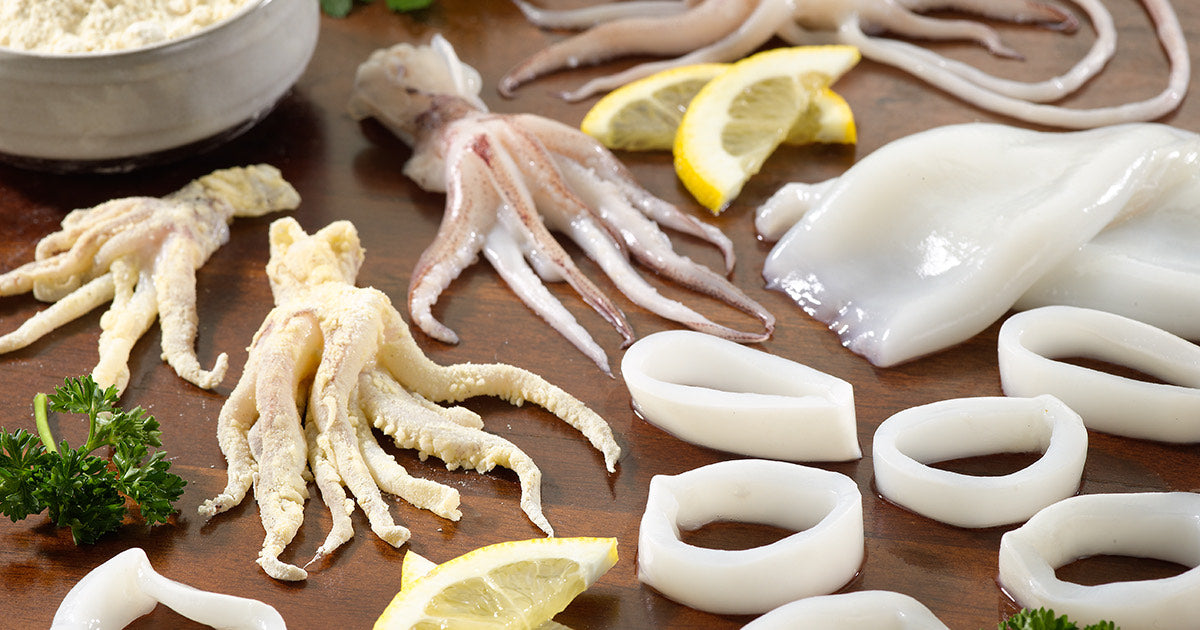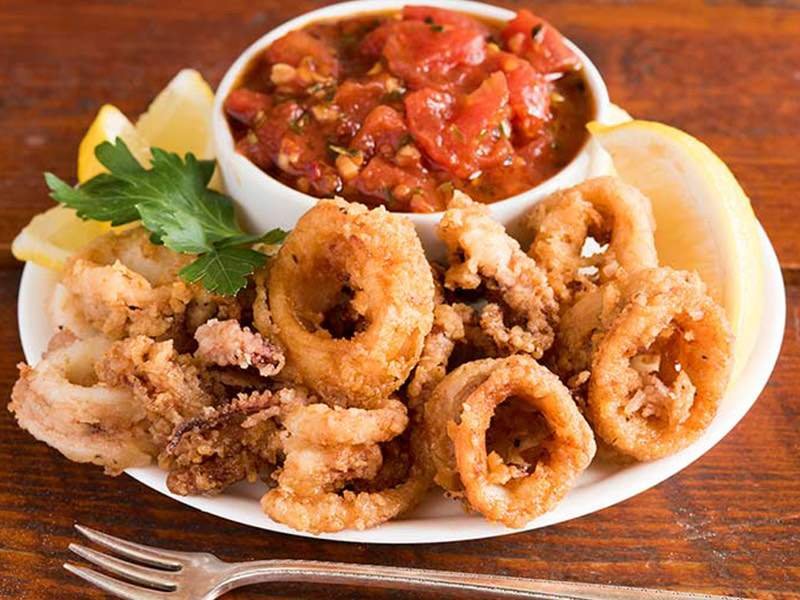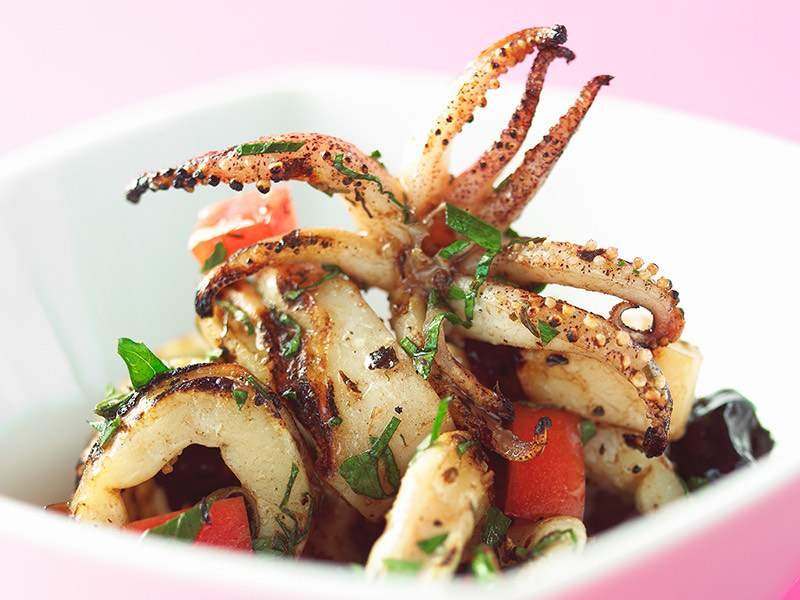Your Essential Guide to Squid

Get to know one of America's most beloved seafoods, squid, with Robert DiGregorgio, FultonFishMarket.com’s Head of Quality Control.
It used to be that squid, like several other things, had a very small market in the United States, limited mainly to Mediterranean and Asian cuisines. But thanks to some clever marketing, “calamari” is now found everywhere. Calamari, especially fried calamari, is now considered an American staple, found on menus everywhere. And it should be. We have some of the best squid in the world right off our shores.
Now, a little description for those unfamiliar with our beautiful squid. We’re speaking of Loligo pealeii, the so-called long fin squid. Found off the East Coast of the U.S., it has 10 arms - two very long ones to snag prey and eight shorter ones. It can flash colors and change patterns to confuse predators and attract a mate, and is fished commercially from Georges Bank to Cape Hatteras.
Wait…is it Squid or Calamari?
Fishing boats from all over the world used to come here to fish, some just for the squid. Foreign vessels used to sit 12 miles off our shore and fish with impunity. They were practically vacuuming the ocean floor and our fishermen were getting crushed. Factory ships from Russia, Poland, Spain, Japan and beyond used to process and freeze tons and tons of our fish and squid. Our fishermen, with only a 12 mile exclusive economic zone (EEZ) couldn’t compete. I used to literally sit on the beach and watch this travesty. One of our natural resources was being plundered by foreign nations right before our eyes! Thankfully, at last, there was an outcry and the fishing industry started to pressure elected officials to do something. Finally, in 1976, the Magnuson-Stevens Fishery Conservation and Management Act — MSA for short — was passed. It pushed our exclusive fishing zone to 200 miles, and our fishermen could breathe again. However, a lot of damage had been done to fish stocks and the fish Americans considered popular, such as haddock and flounder, would need years to recover.
Now, we knew there were a lot of squid out there. We knew foreign boats were scooping up tons of it and bringing it home. We needed to shift from fishing the already overfished species and switch to something there was plenty of. Something unexploited and underused by Americans. Something sustainable.
The Cornell Cooperative Extension Division, whose mission it is to improve New York State communities through partnerships in agriculture and food systems, encouraged fishermen to start fishing for different things. The Long Island Fisheries Assistance Program got on board. Soon afterward so did the Empire State Development Program, and last but not least, The Economic Development Administration of the Federal Commerce Department. Since it was now a federal push, the movement went national. Federally issued memos encouraged chefs to put squid on their menus, to cook it different ways, to get the word out about it. Skeptical restauranteurs weren’t sure how well this relatively unknown item would be received, so they began on a trial run to offer it in smaller portions as an appetizer. And, in a stroke of marketing genius, the CCED as well as other agencies encouraged the restaurants to not call it “squid” , but rather call it by its Italian name, “calamari”. Definitely more enticing. Thus a star was born! The rest is squid history.
Some of the great things about eating squid is it has no bones, has a good, firm texture, cooks fast, and is very versatile. Squid soaks up the flavor of whatever it’s cooked in or with. Oops, I mean calamari!
What are the Health Benefits of Squid?
- Squid are high in vitamin B12, selenium, and potassium.
- Squid are low in fat and contain about 50 calories per 100 grams.
- Squid contains high levels of choline, which has been shown to improve brain development and memory and can reduce inflammation throughout the body.
- Squid is relatively high in Omega-3 fatty acids, which may be good for blood flow and supports healthy cholesterol levels.
- Squid contains lutein, an antioxidant pigment known to support eye health.
- Squid contains taurine, which can reduce the risk of heart disease and high blood pressure.
- Squid is a good source of calcium, iron, magnesium, phosphorus, sodium, and zinc.
What Do Squid Eat?
Squid eat a variety of small sea animals like shrimp, clams, mussels, and even other squid. Squid are carnivorous in nature, so they will eat anything that they can fit in their mouths.
How to Clean Squid
- Grasp the tail in one hand and the head in the other and firmly pull apart with a slight twisting motion. When the head separates from the body most of the guts will come out, connected to the head.
- Place your knife just behind the eyes of the portion containing the tentacles and cut straight down.
- Once the tentacles are cut from the head, squeeze the connective tissue at the top and the bony beak will easily come out.
- Grasp the cartilage inside the body tube with your fingers and pull it away. Then cut away the thin flaps on either side of the body.
- Peel off the skin (optional).
- Rinse the squid and thoroughly pat dry. Make sure to clean the body really well as there will be ink on the squid.
What Does Squid Ink Taste Like?
Believe it or not, squid ink is edible! Squid ink is blue in color and looks like paint when dried out on paper. Squid ink is used in various recipes for its unique salty flavor. Some people describe the taste as similar to spinach while others report that it tastes more like salty seawater.
What is Calamaretti?
Another kind of squid is calamaretti (Loligo vulgaris). These are small European squid and are, in many ways, similar to our long fin squid. These are found in shallow waters from the North Sea to the west coast of Africa. Europeans have been eating squid for centuries, and Spanish calamaretti are considered some of the best and most sought after.
Our Best Squid Recipes
Whether you call it squid or calamari, you are sure to enjoy this delicious and simple recipe for fried calamari with dipping sauce.
This delicious grilled squid salad recipe is ready in minutes, making it the perfect midweek dinner or weekend lunch. The recipe is highly adaptable: don’t have parsley? Use cilantro! Or toss with fresh greens to make it an even more substantial meal.
Take a trip to the Italian coast without leaving your house with our easy grilled squid recipe! Calamari Alla Griglia (Grilled Squid with Tomatoes) uses our fresh calamari (squid) with the simple addition of tomatoes, garlic, and lemon. This easy recipe goes from grill to table in less than 30 minutes.



